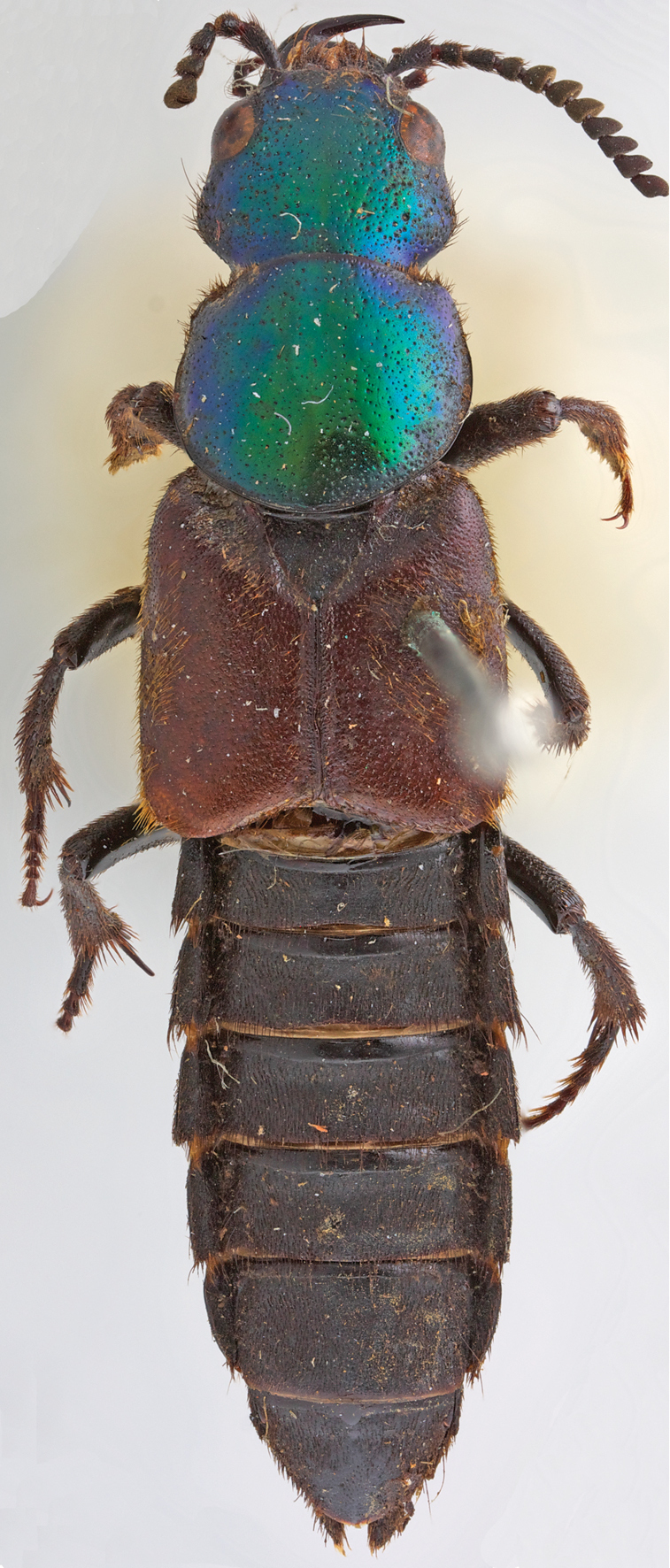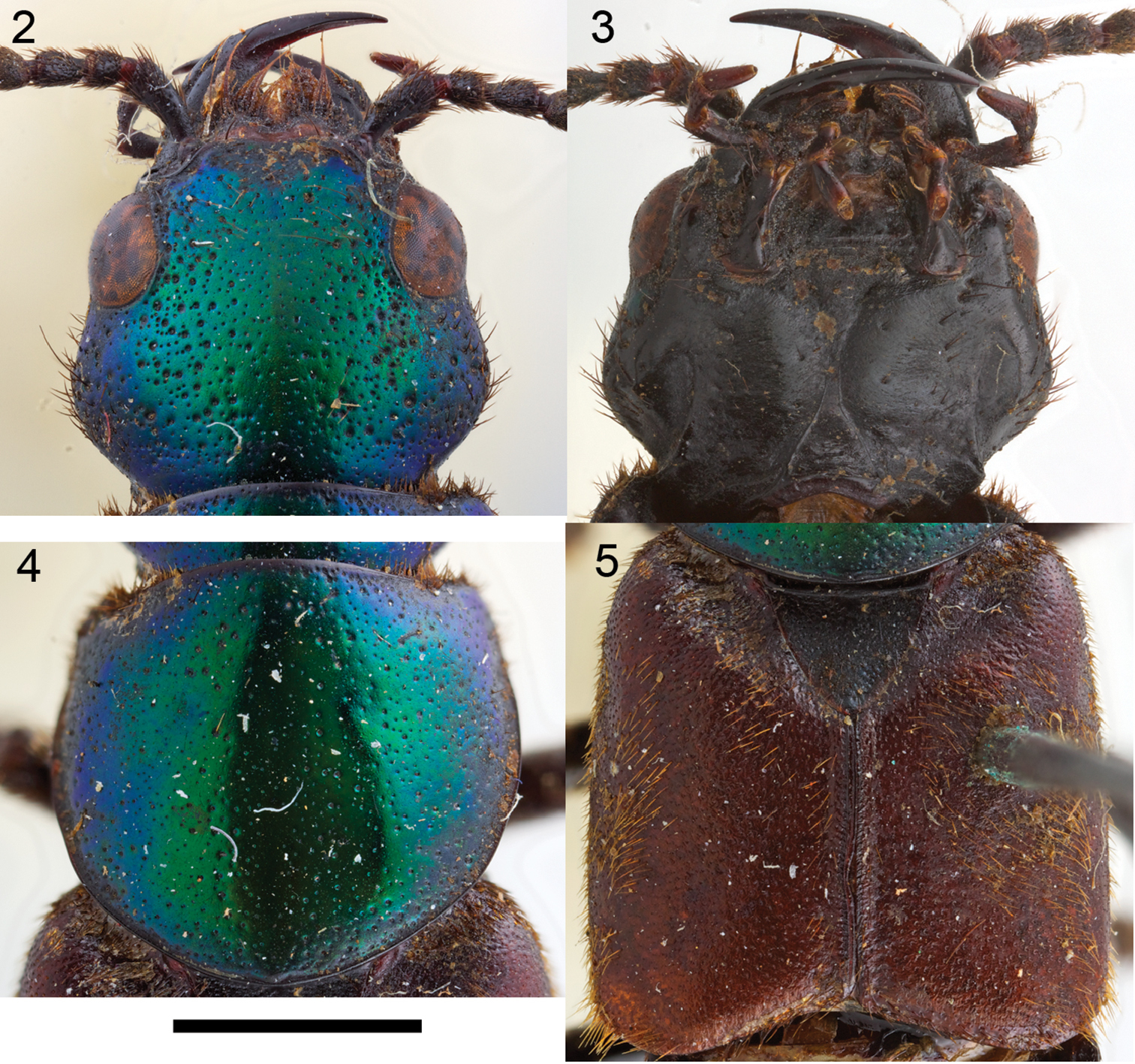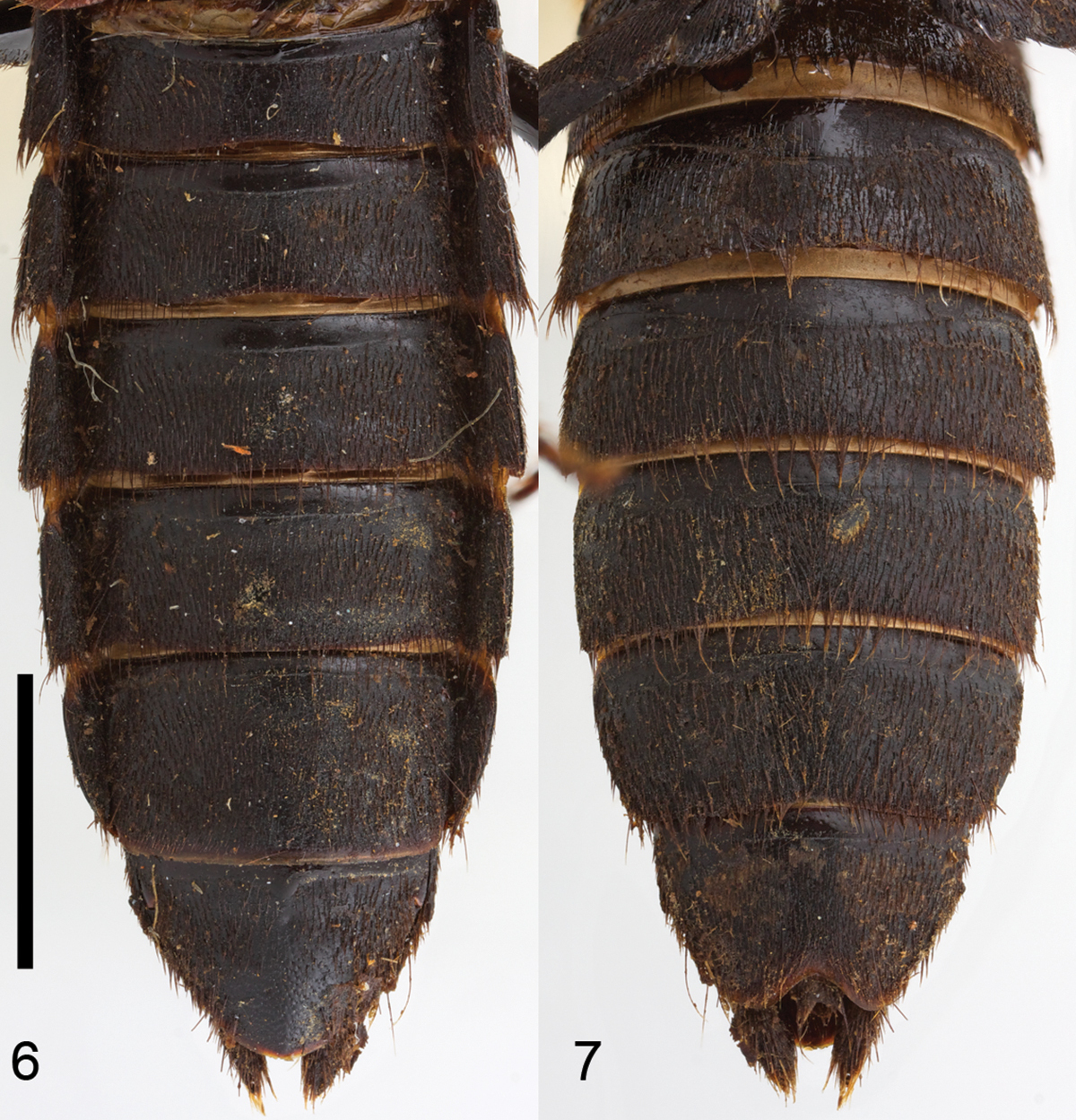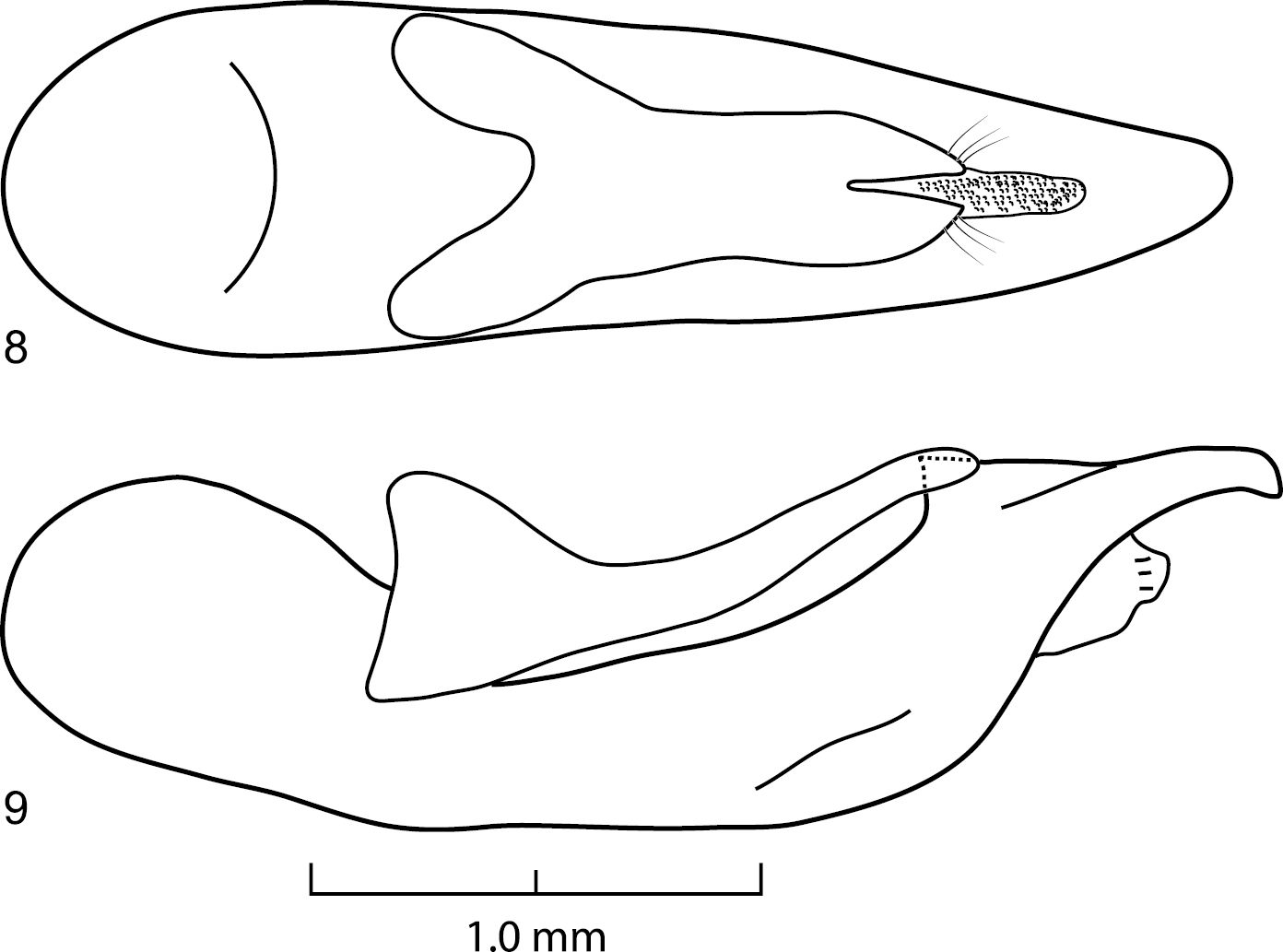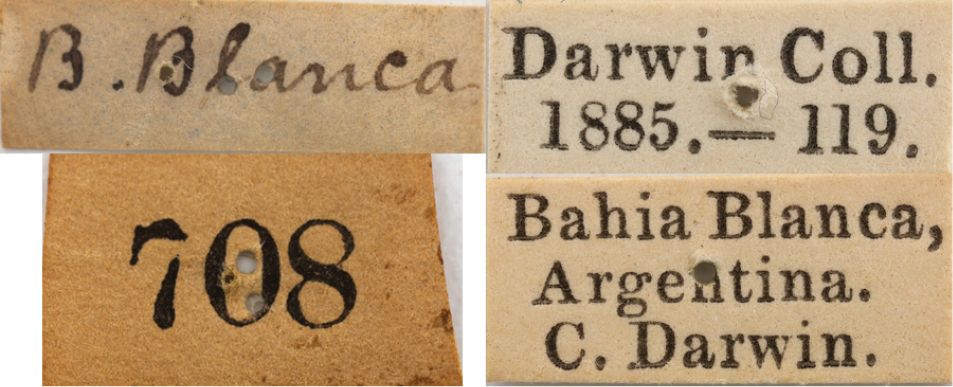






Citation: Chatzimanolis S (2014) Darwin’s legacy to rove beetles (Coleoptera, Staphylinidae): A new genus and a new species, including materials collected on the Beagle’s voyage. ZooKeys 379: 29–41. doi: 10.3897/zookeys.379.6624
A species of xanthopygine rove beetles is described and figured here as Darwinilus sedarisi gen. n. and sp. n. The holotype was collected by Charles Darwin in Bahía Blanca, Argentina on the Beagle’s voyage. The contributions of Charles Darwin to rove beetle systematics are summarized briefly.
Argentina, Neotropical, South America, Staphylininae, Staphylinini, Xanthopygina
Charles Darwin was an avid beetle collector and his contributions to the study of entomology have been extensive (
Based on the annotated Insect Notes (
Checklist of rove beetles collected by Charles Darwin on the Beagle’s Voyage. The list has been extracted from
| Date | No. | Locality | Subfamily: Tribe: Subtribe | Species | Comments | Reference |
|---|---|---|---|---|---|---|
| 1832-ii-16 | 229 | St. Paul’s Rocks, Brazil | Specimen not found; hypothesized by |
|||
| 1832-iv | 415 | Rio de Janeiro, Brazil | Scaphidiinae: Scaphisomatini | Scaphisoma elongatum Waterhouse, 1879 | Species described from Darwin specimen. | |
| 1832-ix | 708 | Bahía Blanca, Argentina | Staphylininae: Staphylinini: Xanthopygina | Darwinilus sedarisi Chatzimanolis, gen. n. and sp. n. | Specimen listed as “not found” in |
this paper |
| 1832-xii-20 | 906 | Navarin Is., Chile | Aleocharinae: Oxypodini | Nordenskjoldella flavitarsis Enderlein, 1912 | Type material not based on Darwin specimen. | |
| 1833-iii | 1151 | Tierra del Fuego | Aleocharinae: Homalotini | Leptusa (Halmaeusa) atriceps (Waterhouse, 1875) | Originally described as Phytosus darwini |
|
| 1834-i | 2002 | Port St Julian [Puerto San Julián], Argentina | Specimens not found. | |||
| 1834 | 2369 | Archipelago of Chiloé, Chile | Microsilphinae | Microsilpha ocelligera (Champion, 1918) | Originally described in Micragyrtes; type materials based on Darwin materials. | |
| 1834 | 2371 | Archipelago of Chiloé, Chiloé Is., Chile | Aleocharinae: Oxypodini | Polylobus darwini Bernhauer, 1935 | Species described from Darwin specimen. | |
| 1834-xii | 2424 | Archipelago of Chronos, Chile | Specimens not found; Darwin commented that “Pselaphidae and small Staphylinidae the most abundant insects” | |||
| 1835 | 3426 | Galapagos Archipelago, San Cristóbal Is., Ecuador | Staphylininae: Staphylinini | Creophilus galapagensis Clarke, 2011 | Type material not based on Darwin specimen. | |
| 1835-ii | 3445 | Hobart Town, Tasmania, Australia | Specimens not found; hypothesized by P. Hammond to be Creophilus erythrocephalus F. | |||
| 1835-ii | 3524 | Hobart Town, Tasmania, Australia | Scaphidiinae: Scaphisomatini | Scaphisoma instabile Lea, 1926 | Lectotype not based on Darwin specimen. | |
| 1836-vii | 3730 | St. Helena | Scydmaeninae: Cyrtoscydmini | “Anthicus wollastoni” Waterhouse, 1879 | The type was based on Darwin material; not Anthicidae but Scydmaeninae (in Euconnus) according to |
|
| 1836-vii | 3730 | St. Helena | Oxytelinae: Oxytelini | Oxytelus alutaceifrons Wollaston, 1877 | Type material not based on Darwin specimen. |
Over the last several years, I have been working towards revising all genera in the rove beetle subtribe Xanthopygina, a group of large and colorful rove beetles distributed in the New World tropics (
Specimens were studied using an Olympus SZX10 dissecting microscope. Specimens examined were loaned from the Natural History Museum, London (BMNH; Roger Booth) and the Museum für Naturkunde der Humboldt Universität (ZMHB; M. Uhlig, B. Jaeger). The 181-year old Darwin specimen was relaxed carefully using the steam method described in a Natural History Museum (London) blog post by curator Beulah Garner, (http://www.nhm.ac.uk/natureplus/blogs/beetles/2011/11/05/steamy-beetles-or-whats-the-point). The paratype was already dissected when I received the specimen from ZMHB. Some aspects of the morphology (e.g., extensive details on mouthparts) were not described due to the fragile state (and at the same time high scientific value) of both specimens. Photographs were taken using a Visionary Digital Passport system with a Canon EOS 40D. Final images were automontaged using Helicon Focus 4.2.9 Pro (http://www.heliconsoft.com/heliconfocus.html). Total length of the specimens is measured from the anterior margin of frons to the posterior margin of segment VIII; width: length measurements were made on the widest: longest part of the structure. Measurements were made with an ocular micrometer. The comparison of the length of the parameres and the median lobe excludes the bulbous basal portion of the median lobe. For type label data, the slash “/” separates different labels. Morphological terminology follows
Darwinilus sedarisi Chatzimanolis, sp. n.
Darwinilus can be distinguished from all other Xanthopygina genera by the combination of the following characters: a) serrate antennae (antennomeres 5–11; antennomeres 6–10 asymmetrical in Terataki Chatzimanolis, Triacrus Nordmann and Trigonopselaphus but not as in Darwinilus); b) clypeus with shallow emargination; c) protibia strongly curved and d) absence of porose structure on abdominal sternite VII in males. Darwinilus is probably closely related to the genera Terataki Chatzimanolis and/or Haematodes Laporte and Weiserianum Bernhauer but can be easily distinguished from these genera by the presence of serrate antennae in Darwinilus and the lack of porose structure on abdominal sternite VII in males (present in Terataki, Haematodes and Weiserianum).
Habitus as in Fig. 1, body large, robust. Head hexagonal in shape (Figs 2–3), widest at temples. Eyes medium-sized, positioned anteriorly, distance between eyes as wide as twice length of eye. Postoccipital suture and ventral basal ridge present; presence of infraorbital ridge not clear but ridge situated between postmandibular ridge and gular suture extends from posterior to middle part of gena; postmandibular ridge present and prominent; gular sutures converging medially; without neck (no nuchal ridge). Epicranium with large prominent macrosetae around lateral margins. Anteclypeus expanded, clypeus with small v-shaped emargination medially. Antennae serrate, 11–segmented; antennomeres 1–3 with several rows of macrosetae; antennomeres 4–11 covered with microtrichiae. Mouthparts with labrum medially emarginate to its base. Mandibles curved, elongate, symmetrical, with prominent fold extending from base to near middle; right mandible with at least one prominent tooth; prostheca setose. Maxilla with galea and lacinia setose; maxillary palpi 4-segmented; palpomeres with several large setae; P1 short; P2–P4 elongate; P2–P3 curved, wider distally; P2 2.2 times as long as P1; P3 shorter than P2; P4 subequal to P3, rounded apically. Labium with mentum having two anterolateral setae on each side; ligula short, entire; labial palpi 3-segmented; P1 subequal to P2; P2 widest anteriorly, with many large setae; P3 elongate, longer than P2, securiform [but not as dilated as in Zackfalinus Chatzimanolis or Dysanellus Bernhauer; see
Habitus of the holotype of Darwinilus sedarisi Chatzimanolis, sp. n. Total length = 21.5 mm Image Copyright Natural History Museum (London).
Head and thorax of the holotype of Darwinilus sedarisi Chatzimanolis, sp. n. 2 Head, dorsal view 3 Head, ventral view 4 Pronotum 5 Elytra. Scale = 2.2 mm Image Copyright Natural History Museum (London).
Abdomen of the holotype of Darwinilus sedarisi Chatzimanolis, sp. n. 6 Dorsal view 7 Ventral view. Scale = 3 mm Image Copyright Natural History Museum (London).
Aedeagus of Darwinilus sedarisi Chatzimanolis, sp. n. 8 Dorsal view 9 Lateral view.
The genus name is derived from the word “Darwin” in honor of Charles Darwin who collected the beetle during the voyage of the Beagle. The name is masculine.
http://zoobank.org/6AB0C47D-5A4B-4D59-AB99-E188FB1E95D2
http://species-id.net/wiki/Darwinilus_sedarisi
Figs 1–10Bahía Blanca, Argentina.
Male, dry pinned, with labels as follows: “B. Blanca” / “708” / “Darwin Coll. 1885.-119.” / “Bahía Blanca, Argentina. C. Darwin.” / “?Trigonopselaphus A. Solodovnikov det. 2007” / “Holotype Darwinilus sedarisi Chatzimanolis des.
Original BMNH labels for the holotype of Darwinilus sedarisi Chatzimanolis, sp. n. Image Copyright Natural History Museum (London).
As for the genus.
Body length 20.0–21.5 mm. Coloration of head and pronotum metallic green with blue-purple overtones near margins. Elytra light brown. Mouthparts, mesoscutellum, legs, abdomen and ventral surface of body dark brown-black. Antennae dark brown except antennomeres 4–7 appearing yellowish brown due to the presence of yellow microtrichiae. Head slightly transverse, width: length ratio = 1.23. Dorsal surface of head with uniform dense polygon-shaped microsculpture, small punctures interspersed and medium to large size punctures throughout except medially. Ventral surface of head with transverse microsculpture, micropunctures and few large punctures along borders of gula and directly posterior to mandibles. Antennomeres 1–3 longer than wide; antennomere 4 shorter but wider than 3; antennomere 5 narrower than 6; antennomeres 6–7 subequal in size; antennomere 8 slightly wider than 7; antennomeres 8–10 subequal in size; antennomeres 5–11 serrate. Pronotum width: length ratio = 1.08, widest medially; with uniform dense polygon-shaped microsculpture; small punctures interspersed and medium to large size punctures throughout except medial line; medium to large size punctures also present around margin of pronotum but not in rows as is typical in other Xanthopygina. Mesoscutellum with polygon-shaped microsculpture and uniform small almost confluent punctures. Elytra longer than pronotum; with dense polygon-shaped microsculpture and uniform punctation consisted of medium-sized almost confluent punctures; sutures of elytra with 2–3 rows of micropunctures on each side. Abdominal tergites with dense transverse microsculpture and uniform small-sized punctures; punctures almost confluent except punctation less dense medially on tergites III–IV. Sternum with uniform dense punctuation consisted of small punctures; additional irregular row of larger punctures near posterior margin on sternites V–VII; sternum with transverse microsculpture. Male secondary sexual structures: posterior border of sternite VIII having deep V-shaped emargination medially; sternite IX with shallow U-shaped emargination. Aedeagus as in Figs 8–9; paramere separated anteriorly into two lobes; lobes slightly asymmetrical; paramere much shorter and narrower than median lobe; paramere without peg setae; in dorsal view each paramere lobe converging to rounded apex; in lateral view paramere curved upwards. Median lobe in dorsal view wide, converging to rounded apex; with single large dorsal tooth; in lateral view median lobe curved upwards to prominent tooth, then becoming much narrower and slightly curved downwards to rounded apex.
The species is named in honor of Mr David Sedaris, a prolific writer, as an appreciation for his fascination with the natural world. I spent many hours listening to Mr Sedaris’ audiobooks while preparing the specimens and the figures for this and other manuscripts.
Known from Bahía Blanca, Buenos Aires and Río Cuarto, Córdoba in Argentina.
Unknown; the climate in the areas mentioned above is humid subtropical to humid temperate. However, agricultural fields have replaced the original habitat in these localities.
It is rather remarkable that only two specimens are known for such a large species. I have examined the rove beetle collections of most major museums in North America and Europe but unfortunately I was not able to locate any additional specimens. One explanation might be that this species lives in refuse piles of ants or other Hymenoptera (see below for further discussion).
The Darwin specimen described in this paper as the holotype of Darwinilus sedarisi was given the specimen number 708 in the Insect Notes held by Darwin and Syms Covington (Darwin’s servant). Until now, this specimen was considered lost (or “not found”) according to
Darwinilus is superficially similar to Trigonopselaphus (due to the large habitus) but it is probably more closely related to the newly erected genus Terataki (
No data were available regarding the natural history of Darwinilus sedarisi. The genus Weiserianum, hypothesized to be related to Darwinilus, is known to be a myrmecophile (leafcutter ants;
I am grateful to my colleague A. Solodovnikov who mentioned in early 2008 that there was a “Darwin xanthopygine” in BMNH. I thank Al Newton for the notes on rove beetle species described by Darwin and anecdotes regarding a Field Museum specimen. I am in debt to the curators and collection managers in BMNH and ZMHB for the loan of specimens and their hospitality. I thank Michael S. Engel, Cheryl Murphy, Alexey Solodovnikov and an anonymous reviewer for comments on a previous version of the manuscript. The Natural History Museum of London kindly allowed me to photograph the holotype, they retain the copyright of the photographs.
